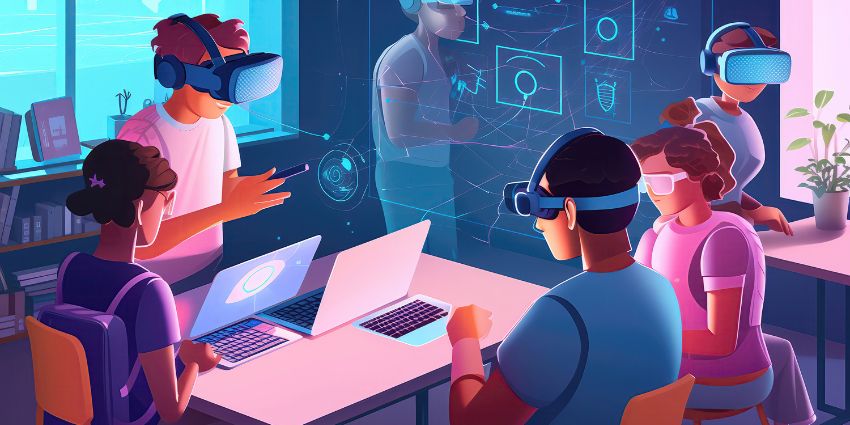Immersive learning solutions, tools, and software are taking the world by storm. For years, companies have recognized the need to provide consistent training and development resources to staff. After all, on average, employees learn about 70% of their skills on the job.
However, the evolution of the workplace is making it harder for companies to train teams using traditional methods. In the world of remote and hybrid work, it’s almost impossible to give everyone access to the same in-person lessons and seminars.
Moreover, many traditional teaching methods can’t simulate specific situations and experiences realistically without putting students at risk. Fortunately, that’s where immersive learning comes in.
Leveraging extended reality, the metaverse, and even artificial intelligence, immersive learning solutions transform education with memorable, experiential classes and courses. Here’s why companies should consider investing in immersive learning in 2024.
1. Enhanced Knowledge Retention and Recall
Probably the most obvious reason to invest in immersive learning solutions is they can help to improve the outcomes of your training and development strategies.
Immersive technologies make learning “experiential”. In other words, they allow users to get hands-on experience in realistic, simulated environments. Students don’t just learn the theory behind skills; they get to put that theory into practice, interacting with digital scenarios and avatars.
For instance, in a contact center, an agent can use a VR app to interact with an AI customer avatar in real time, evaluating how specific actions influence the customer’s responses and sentiments. According to studies, experiential learning accelerates the mastery of expertise.
Some reports indicate that a 15-minute session in VR can drive the same amount of knowledge development as watching a 1.5-hour documentary. Additionally, because immersive learning solutions activate multiple senses, and connect with students emotionally, they can improve memory retention.
We’re more likely to remember what we learn from an immersive experience than we are to recall information from videos or textbooks.
2. Immersive Learning Solutions Reduce Risk
In many environments, students need hands-on experience with specific scenarios and tools to develop their skills. It’s challenging to learn how to operate heavy machinery just by looking at a book. However, placing people in situations requiring specific knowledge and expertise is also dangerous. Immersive learning solutions can help.
With AR, VR, MR, and metaverse technologies, people can navigate dangerous environments without risk. Doctors can practice complex surgeries on virtual patients without risking their health and safety. Industrial professionals can learn how to operate a crane without being inside one.
Even members of the emergency services landscape, like firefighters and police officers, can learn how to deal with potentially life-threatening situations risk-free. With immersive learning solutions, trainees experience situations that would usually be unsafe safely.
3. Improved Insights and Analytics
Using immersive technology to train employees and students is a great way to capture more information about the educational journey and the development of teams. With extended reality technology, you can capture more data than you would from most traditional training tools.
While basic online courses and learning management systems can show how many employees completed a course and the average score they got, XR tools can offer you a lot more.
You can see the correlation between how a person interacts with immersive content and how they consume information. You can find how people respond emotionally to certain types of content by tracking their heart rate and eye movements. This opens the door to creating more impactful educational content, accelerating knowledge transfer, and improving retention.
Instructors can use the information from XR tools to make immersive learning experiences more fun and engaging.
4. Immersive Learning Solutions Keep Learners Focused
Realistically, the traditional learning environment is full of distractions. In a workplace, trainers constantly fight for a learner’s attention against interruptions from colleagues or background noise. Even employees learning at their own pace with online videos and courses tend to scroll through social media or respond to emails when listening to content.
Bringing extended reality into the educational experience, with immersive learning, helps to eliminate these distractions. Technology places the learner at the heart of the learning experience, forcing them to constantly interact with content and pay attention to what’s happening around them.
VR is particularly effective at improving focus, as it places students in a comprehensive world they can explore, removing external distractions, noise, and images. PWC even found that people are four times more focused during VR training sessions than in other learning environments.
Additionally, because the immersive experience is fun and exciting, students are more likely to commit to completing the course. VirtualSpeech, a company providing e-learning courses, found VR courses had 30-40% higher completion rates.
5. Boosted Accessibility and Participation
As mentioned above, in the modern workplace, delivering traditional learning experiences to every employee is becoming challenging. While your in-office staff might be able to attend a training session and interact with course material, your remote employees will miss out. They won’t get the same experience just by watching a recording.
Immersive learning solutions ensure you can deliver the same powerful experience to every staff member. VR experiences and AR apps can be shared via the cloud with every employee, regardless of location. Additionally, immersive learning platforms can allow companies to customize these training initiatives to suit the needs of each employee.
Not only does this improve the accessibility of training sessions, but it also means more employees are likely to get involved and invest in their education. Immersive learning is exciting, interactive, and fun.
6. Save Time, Money, and the Environment
Finally, immersive learning solutions can be more cost-effective than traditional development programs. While there are some initial investments to consider, like AR software development costs or paying for XR headsets, you save money in other ways.
Instructors and employees don’t have to travel to a specific location to attend classes, reducing transportation costs. There’s no need to hire any training rooms or classroom spaces, and you don’t have to put your high-cost machinery at risk by exposing it to untrained staff.
Additionally, once you’ve created a lesson with immersive training solutions, you can share it with endless employees. You don’t need to pay an instructor to come and host endless sessions with new staff members and different groups.
Immersive learning solutions can save companies significant money in the long term. Plus, eliminating the need for travel saves employees time and improves the impact your business has on the environment.
Ready to Invest in Immersive Learning Solutions?
Immersive learning solutions could be the future of education, both in schools and universities, and in the employee training landscape. With the right immersive tools and technologies, you can scale development strategies without restrictions or significant costs.
Plus, you can develop a learning experience that increases student engagement, improves knowledge retention, and even enhances workplace safety.







